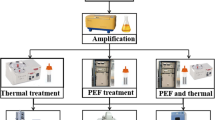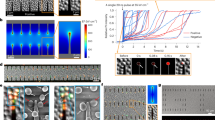Abstract
Inactivation of microorganisms with pulsed electric fields is one of the nonthermal methods most commonly used in biotechnological applications such as liquid food pasteurization and water treatment. In this study, the effects of microsecond and nanosecond pulses on inactivation of Escherichia coli in distilled water were investigated. Bacterial colonies were counted on agar plates, and the count was expressed as colony-forming units per milliliter of bacterial suspension. Inactivation of bacterial cells was shown as the reduction of colony-forming units per milliliter of treated samples compared to untreated control. According to our results, when using microsecond pulses the level of inactivation increases with application of more intense electric field strengths and with number of pulses delivered. Almost 2-log reductions in bacterial counts were achieved at a field strength of 30 kV/cm with eight pulses and a 4.5-log reduction was observed at the same field strength using 48 pulses. Extending the duration of microsecond pulses from 100 to 250 μs showed no improvement in inactivation. Nanosecond pulses alone did not have any detectable effect on inactivation of E. coli regardless of the treatment time, but a significant 3-log reduction was achieved in combination with microsecond pulses.





Similar content being viewed by others
References
Agerholm-Larsen B, Linnert M, Iversen HK, Gehl J (2011) Drug and gene electrotransfer to the brain. In: Kee ST, Gehl J, Lee EW (eds) Clinical aspect of electroporation. Springer, New York, pp 129–135
Álvarez I, Pagán R, Condón S, Raso J (2003) The influence of process parameters for the inactivation of Listeria monocytogenes by pulsed electric fields. Int J Food Microbiol 87:87–95
Aronsson K, Lindgren M, Johansson BR, Rönner U (2001) Inactivation of microorganisms using pulsed electric fields: the influence of process parameters on Escherichia coli, Listeria innocua, Leuconostoc mesenteroides and Saccharomyces cerevisiae. Innov Food Sci Emerg Technol 2:41–54
Barbosa-Cánovas G, Góngora-Nieto M, Pothakamury U, Swanson B (1999) Preservation of foods with pulsed electric fields. Academic Press, San Diego
Bertacchini C, Margotti PM, Bergamini E, Lodi A, Ronchetti M, Cadossi R (2007) Design of an irreversible electroporation system for clinical use. Technol Cancer Res Treat 6:313–320
Calderon-Miranda ML, Barbosa-Canovas GV, Swanson BG (1999) Inactivation of Listeria innocua in liquid whole egg by pulsed electric fields and nisin. Int J Food Microbiol 51:7–17
Chang DC, Reese TS (1990) Changes in membrane structure by electroporation as revealed by rapid-freezing electron microscopy. Biophys J 58:1–12
Davalos RV, Mir LM, Rubinsky B (2005) Tissue ablation with irreversible electroporation. Ann Biomed Eng 33:223–231
Fuller GW (1898) Report on the investigations into the purification of the Ohio River water at Louisville Kentucky. D. Van Nostrand, New York
Gusbeth C, Frey W, Volkmann H, Schwartz T, Bluhm H (2009) Pulsed electric field treatment for bacteria reduction and its impact on hospital wastewater. Chemosphere 75:228–233
Hamilton WA, Sale AJH (1967) Effects of high electric fields on microorganisms: I. Killing of bacteria and yeast. Biochim Biophys Acta 148:781–788
Heinz V, Alvarez L, Angersbach A, Knorr D (2002) Preservation of liquid foods by high intensity pulsed electric fields—basic concepts for process design. Trends Food Sci Technol 12:103–111
Hülsheger H, Pottel J, Niemann E (1981) Killing of bacteria with electric pulses of high field strength. Radiat Environ Biophys 20:53–65
Jayaram S, Castle G, Margaritis A (1992) Kinetics of sterilization of Lactobacillus brevis by the application of high voltage pulses. Biotech Bioeng 40:1412–1420
Kotnik T, Miklavcic D (2006) Theoretical evaluation of voltage inducement on internal membranes of biological cells exposed to electric fields. Biophys J 90:480–491
Kümmerer K (2001) Drugs in the environment: emission of drugs, diagnostic aids and disinfectants into wastewater by hospitals in relation to other sources—a review. Chemosphere 45:957–969
Lee EW, Chen C, Prieto VE, Dry SM, Loh CT, Kee ST (2010) Advanced hepatic ablation technique for creating complete cell death: irreversible electroporation. Radiology 255:426–433
Martín-Belloso O, Qin B, Chang F, Barbosa-Cánovas G, Swanson B (1997) Inactivation of Escherichia coli in skim milk by high intensity pulsed electric fields. J Food Process Eng 20:317–336
Marty M, Sersa G, Rémi Garbay J, Gehl J, Collins CG, Snoj M, Billard V, Geersten PF, Larkin JO, Miklavcic D, Pavlovic I, Paulin-Kosir SM, Cemazar M, Norsli N, Soden DM, Rudolf Z, Robert C, O’Sullivan GC, Mir LM (2006) Electrochemotherapy—an easy, highly effective and safe treatment of cutaneous and subcutaneous metastases: results of ESOPE (European standard operating procedures of electrochemotherapy) study. EJC Suppl 4:3–13
Mosqueda-Melgar J, Raybaudi-Massilia RM, Martín-Belloso O (2007) Influence of treatment time and pulse frequency on Salmonella enteritidis, Escherichia coli and Listeria monocytogenes populations inoculated in melon and watermelon juices treated by pulsed electric fields. Int J Food Microbiol 117:192–200
Neumann E, Rosenheck K (1972) Permeability changes induced by electric impulses in vesicular membranes. J Membr Biol 14:194–196
Paraskeva P, Graham NJ (2002) Ozonation of municipal wastewater effluents. Water Environ Res 74:569–581
Pataro G, Senatore B, Donsi G, Ferrari G (2011) Effect of electric and flow parameters on PEF treatment efficiency. J Food Eng 105:79–88
Perni S, Charlise PR, Shama G, Kong MG (2007) Bacterial cells exposed to nanosecond pulsed electric fields show lethal and sublethal effects. Int J Food Microbiol 120:311–314
Reasoner DJ (2004) Heterotrophic plate count methodology in the United States. Int J Food Microbiol 92:307–315
Reberšek M, Miklavčič D (2011) Advantages and disadvantages of different concepts of electroporation pulse generation. Automatika 52:12–19
Rieder A, Schwartz T, Schön-Hölz K, Marten S, Süss J, Gusbeth C, Kohnen W, Svoboda W, Obst U, Frey W (2008) Molecular monitoring of inactivation efficiencies of bacteria during pulsed electric field treatment of clinical wastewater. J Appl Microbiol 105:2035–2045
Rols MP (2006) Electropermeabilization, a physical method for the delivery of therapeutic molecules into cells. Biochim Biophys Acta 1758:423–428
Rook JJ (1977) Chlorination reactions of fulvic acids in natural waters. Environ Sci Technol 11(5):478–482
Rubinsky B (2007) Irreversible electroporation in medicine. Technol Cancer Res Treat 6:255–259
Sanders JM, Kuthi A, Wu Y, Vernier PT, Gundersen MA (2009) A linear, single-stage, nanosecond pulse generator for delivering intense electric fields to biological loads. IEEE Trans Dielectr Electr Insul 16:1048–1054
Saulis G (2010) Electroporation of cell membranes: the fundamental effects of pulsed electric fields in food processing. Food Eng Rev 2:52–73
Schoenbach KH, Joshi RP, Stark RH (2000) Bacterial decontamination of liquids with pulsed electric fields. IEEE Trans Dielectr Electr Insul 7:637–645
Schwartz T, Hoffman S, Obst U (2003) Formation of natural biofilms during chlorine dioxide and UV disinfection in a public drinking water distribution system. J Appl Microbiol 95:591–601
Sersa G, Miklavcic D, Cemazar M, Rudolf Z, Pucihar G, Snoj M (2008) Electrochemotherapy in treatment of tumors. Eur J Surg Oncol 34:232–240
Teissié J, Eynard N, Vernhes MC, Bénichou A, Ganeva V, Galutzov B, Cabanes PA (2002) Recent biotechnological developments of electropulsation. A prospective review. Bioelectrochemistry 55:107–112
Weaver JC (2003) Electroporation of biological membranes from multicellular to nano scales. IEEE Trans Dielectr Electr Insulation 10:754–768
Wu Y, Mittal GS, Griffiths MW (2005) Effect of pulsed electric field on the inactivation of microorganisms in grape juices with and without antimicrobials. Biosyst Eng 90:1–7
Acknowledgements
The authors thank Prof. Dr. Damijan Miklavčič, who read the manuscript and provided comments and insights that improved it. This research was supported by the Slovenian Research Agency under research program P2-0249, MRIC UL IP-0510 and research project L2-4314. The research was conducted in the scope of EBAM, European Associated Laboratory.
Author information
Authors and Affiliations
Corresponding author
Rights and permissions
About this article
Cite this article
Žgalin, M.K., Hodžić, D., Reberšek, M. et al. Combination of Microsecond and Nanosecond Pulsed Electric Field Treatments for Inactivation of Escherichia coli in Water Samples. J Membrane Biol 245, 643–650 (2012). https://doi.org/10.1007/s00232-012-9481-z
Received:
Accepted:
Published:
Issue Date:
DOI: https://doi.org/10.1007/s00232-012-9481-z




